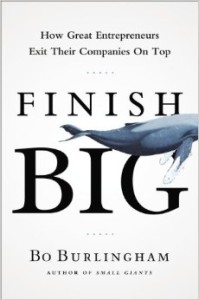 Not many books found in the business section of the bookstore are written about the exit strategy of small business owners. While you will find countless texts on Marketing, Management, Growth and Development, seldom is much consideration given to the financial, social and psychological implications of ending a career. Bo Burlingham, a frequent contributor to INC. Magazine and author of the book, Small Giants, has taken up the cause with his new book which will be reviewed and discussed in a series of articles on this site over the course of 2015. While dental practices do not usually conform to the definition of Small Businesses (receipts greater than $2.5 million), the experiences of general business entrepreneurs are very similar to dental practice owners. I would suggest that anyone who cares about the future success of the transition of their business to the next generation should pick up a copy of this book and a highlighter and begin a little honest evaluation of your exit strategy.
Not many books found in the business section of the bookstore are written about the exit strategy of small business owners. While you will find countless texts on Marketing, Management, Growth and Development, seldom is much consideration given to the financial, social and psychological implications of ending a career. Bo Burlingham, a frequent contributor to INC. Magazine and author of the book, Small Giants, has taken up the cause with his new book which will be reviewed and discussed in a series of articles on this site over the course of 2015. While dental practices do not usually conform to the definition of Small Businesses (receipts greater than $2.5 million), the experiences of general business entrepreneurs are very similar to dental practice owners. I would suggest that anyone who cares about the future success of the transition of their business to the next generation should pick up a copy of this book and a highlighter and begin a little honest evaluation of your exit strategy.
Well, It’s Happened Again

I recalled an article posted on this site a few years back and believe that it is still on point. A portion of it follows below. For years we have had a Memo of Direction available on our website for those that need a little assistance in getting started with some practice continuation planning. We made it a WORD document so that it can be changed to suit your needs. I will not even be offended if you take our name out and put in another’s. I would prefer someone else be designated rather than no one.
You Want How Much?!
One of Debbie’s and my monthly pleasures is shopping at a local Kansas City antiques center which is only open during the “First Friday” weekend. This particular store epitomizes the word eclectic, and has been the source of numerous purchases. Recently I noticed a couple of 50’s era stools which, although I had no need for them, I thought were really cool. They had been marked at $85 each, but having noticed them not selling for a couple of months, I thought I would flash my negotiation skills and see if I could buy the pair for about $120. Imagine my surprise in finding them not in the usual display but positioned in one of those out-the-door bargain locations for $25 each. Interestingly, though I would have been proud to have bought them for $120, I found myself a little reluctant to hand the cashier $50 for the pair. What happened? Why did it no longer seem like such a good deal?

Obviously the chairs had not changed, nor did the store change their marketing format. The fact is, my perception of their value changed. The chairs went from being kitschy, industrial décor to clearance sale items. Ultimately, I did buy them, but the feeling of victory was tainted.
Write It Off? Not So Fast.
One of the services EMA offers is a pre-transition consultation in which we take stock of the potential seller’s practice and make recommendations about how to best position the practice for sale. This may include our opinions about the physical plant, current technology, service mix, PPO participation, staff size and general marketability. Inevitably though, that conversation will include a comment referring to “cleaning up your financials”. The logic is that practices with clean Profit and Loss statements and tax returns just “show” better to prospective buyers and consequently sell faster. Recent revelations from the banking industry though have caused us to reconsider how important this particular point may be in accomplishing a sale and transition.

Come on, we’ve all done things like putting a spouse and/or children on the payroll or buying “Dental Supplies” that ended up in the home pantry. Boats, airplanes, farm animals (yes, we have adjusted “Hay” from the supply bills), inflated rent to owner occupied real estate, artwork and furniture have all been written off as expenses through the practice. We are making no moral judgment here as we understand that small business owners need to take every available advantage of self-employment. In the past we have simply normalized those expenses in an effort to best estimate the true overhead costs and resulting profitability. Buyers and their accountants understood the process and analyzed the opportunity accordingly.
The Perfect Listing? Not Yet!
I have always felt that one of the real blessings and privileges of holding a license to practice dentistry was the ability to control your work environment. You can practice where you want, with whom you choose, at the pace you prefer, doing procedures within your comfort zone and for patients you enjoy treating. Believe me, not many other types of employment allows this sort of flexibility. When you combine this with the lack of oversight (my barber is subject to annual unannounced state inspections of his shop), the practice of dentistry creates a lot of business diversity.

The flip side of this is that very few practices are the same, and from a marketing standpoint, that presents some challenges. While sellers are understandably proud of their businesses, they have created practices for their personal benefit, style and performance level, and prospective buyers often have a different vision. The result is that when the young doctor tells me they are looking for the “Perfect Opportunity”, the sad fact is that I don’t have any in our inventory. Truth be known, I have yet to have a listing without some sort of flaw when compared to the buyer’s wish list. Whether it is the location, staff, revenue, procedure mix, insurance participation, Medicaid, parking lot, bridge construction, curb appeal, lease, technology, geography, equipment, or patient base, something is always at issue. Surprisingly, if properly appraised, price is usually way down the list of concerns.
Exaggerated Rumors of the Demise of the Solo Practice
Having graduated from dental school in 1977, I’m closing in on 40 years of serving and observing our profession. From this perspective, I’m becoming more and more aware of how much of life runs in predictable cycles.

Thinking of myself and many of my peers, I see that our personal lives are very similar to each other in many ways. With some notable exceptions, most of us grew up in somewhat stable home environs, made it through college and dental school, married, had children, and found that dentistry provided a reasonably rewarding career for many years. Now we can see the same cycle repeating with our own children.
Dental Practice Sustainability
I was recently asked to serve on the Sustainability Task Force at my church. It seems that many churches, non-profits and businesses in general are asking members and constituents to sit down and focus on what factors may influence the long term survivability of their organizations and to make plans and recommendations to deal with those issues. This trend is not so much about organizational goals and mission statements as much as it is about the ability to physically survive into the future. Maybe the recent pain of the Great Recession has taught us a few lessons. Topics of discussion might include changing demographics, staff succession plans, physical property needs and management of the organization’s endowments. It occurred to me rather quickly that dental practices could certainly benefit from a similar introspective process.
2013 Mid-Year Thoughts
We are celebrating the 20th anniversary of the founding of our company in 1993 by Mr. Evan Myers. Debbie and I joined him in 2003 and became owners in 2004. Evan retired in 2007 but still drops in every now and then to make sure we’re still working. Proudly, we are and look forward to many more years serving dentist clients in Missouri, Nebraska and Kansas.
The Five Percent Solution, With No Money Down
I am going to bet that just about every 50+ year old dentist reading this has heard of the author, Robert G. Allen. His first book, Creating Wealth, was published in 1983 and would best be described as a quasi-business textbook detailing how to buy real estate with no money down. He did not invent this process as William Nickerson had preceded him with a similar publication in 1959, and he was certainly not the last. Carleton Sheets and Wade Cook also promoted books, seminars and cassette tape learning programs to teach us these magical concepts and make us all real estate millionaires. The plan was simple: given a variety of “creative financing” techniques, you could walk away from a closing as the new owner of a property without using any of your own money. You were then free to hold and rent the property to an adoring tenant or flip it into an even larger number of properties. By repeating the process enough times, you could soon build a large net worth. Oh and what a glorious day it would be when you cashed out, took all the money to the bank and lived happily ever after without lifting a finger. What could possibly go wrong?
I must now share a dirty little secret…I bought into this stuff! I suspect that a large number of readers also shared my interest. The real estate world was a different place in the 70s, 80s and 90s and there was just enough plausibility to the concepts to be very attractive to guys that grew up without the joy of a high net worth lifestyle. Heck, if you would just follow a few simple steps, you too could drive a new Ferrari. I read most of the books, went to a couple of the seminars and listened to those magical cassette tapes while driving my old Fiero (NOT related to Ferrari) until they were worn out. And do you know what? I bought real estate with no money down! It really could be done!
Patient and Staff Retention After the Sale
One of the most frequently asked questions I receive from prospective buyers is my opinion (or perhaps assurance) on whether or not the current patients and staff will stay with the practice after the sale. Since the perceptions and motivations of these two groups is so different, let’s examine each one individually and determine what might be reasonable to expect.
